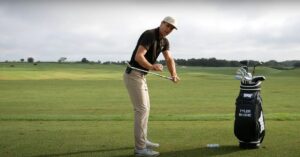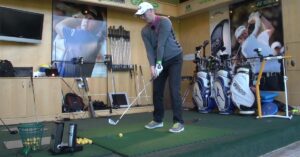How Far To Grip Down On A Golf Club: Mastering Your Golf Swing
Whether you’re a seasoned golfer or just starting to explore the game, one crucial aspect to consider is how you grip your golf club. The position of your hands on the club can significantly impact overall performance . One question that often arises is how far to grip down on a golf club.
A common recommendation is to grip down approximately one inch for every 3-4 inches of shaft length. However, it’s essential to experiment and find the grip position that feels most comfortable and allows you to maintain a solid swing rhythm and balance.
In this blog post, we will delve into this topic, providing you with valuable insights to help you improve your game.
How Do You Grip A Golf Club?

Properly gripping a golf club is essential for achieving control, power, and consistency in your shots. Follow these steps to establish a correct grip:
Step 1. Start with the Left Hand (for Right-Handed Players):
Place the club handle in the fingers of your left hand (opposite for left-handed players) so that it runs diagonally across the base of your fingers.
The grip should lie just below the heel pad of your hand. The club should extend from the base of your pinky finger to the middle joint of your index finger.
Step 2. Form the “V” with Your Thumb and Index Finger:
Wrap your fingers around the grip, making sure your left thumb rests on top of the grip.
The “V” formed between your thumb and index finger should point toward your right shoulder (left shoulder for left-handed players).
Step 3. Add the Right Hand:
Place your right hand on the club with the grip also running diagonally across your fingers.
The “V” formed between your right thumb and index finger should point toward your right shoulder (left shoulder for left-handed players). Align the “V” of your right hand with the “V” of your left hand.
Step 4. Choose an Interlock or Overlap Grip:
There are two common ways to connect your hands: interlocking and overlapping grips. Experiment with both to find the one that feels most comfortable for you.
Interlock Grip
Allow the pinky finger of your right hand to interlock with the index finger of your left hand. This grip is popular among players with smaller hands or those seeking a more connected feeling.
Overlap Grip
Rest the pinky finger of your right hand on top of the index finger of your left hand. This grip is widely used and provides a bit more freedom in the hands.
Step 5. Maintain Grip Pressure
Find a balance in your grip pressure, neither gripping the club too tightly nor holding it too loosely. A moderate grip pressure allows for control and feel while maintaining a relaxed state in your hands and arms.
Step 6. Check Hand Alignment
Take a moment to check the alignment of your hands with the clubface. The back of your left hand and the clubface should be parallel to each other, indicating a square clubface position.
Avoid rotating your left hand too far to the right (strong grip) or left (weak grip), as it can affect the clubface’s orientation at impact.
Step 7. Verify Finger Alignment:
Ensure that your fingers are aligned properly on the grip. Ideally, your left thumb should fit snugly in the lifeline of your right hand (for right-handed players).
This connection helps promote a unified and synchronized motion throughout the swing.
Step 8. Practice and Adjust
Spending time practicing and getting comfortable with your grip is crucial. Experiment with different grip positions and variations to find what works best for you.
Seek guidance from a golf instructor or experienced golfer who can provide feedback and help fine-tune your grip for optimal performance.
6 Common Mistakes When Gripping Down on a Golf Club

When golfers grip down on a club, it means they are placing their hands lower on the grip than the usual position. This technique is commonly employed to gain better control or adjust for shots requiring less distance.
However, there are a few common mistakes that golfers often make when gripping down a golf club.
1. Gripping Too Tight
One frequent mistake is gripping the club too tightly when gripping down. This excessive tension can hinder the fluidity of your swing and reduce your feel for the shot. Instead, maintain a relaxed grip pressure to promote a smooth and natural swing.
2. Neglecting Hand Placement
Another error is disregarding the correct hand placement while gripping down. It’s important to maintain the same hand positioning as a regular grip, ensuring that the “V” formed between both hands’ thumb and index finger align properly.
Avoid allowing your hands to slide apart or overlap excessively.
3. Forgetting about Clubface Alignment:
When gripping down, it’s essential to maintain proper clubface alignment. Some golfers unintentionally rotate their hands, resulting in a closed or open clubface at impact. Take a moment to check that the back of your lead hand remains parallel to the clubface throughout your grip adjustment.
4. Ignoring Weight Distribution:
An often overlooked aspect is neglecting to adjust the weight distribution during a grip down. Since your hands are lower on the grip, it’s crucial to compensate by placing slightly more weight on your front foot.
This adjustment helps maintain balance and control during the swing.
5. Inconsistent Grip Pressure:
Maintaining consistent grip pressure is vital regardless of where your hands are positioned on the grip. Some golfers unintentionally tighten their grip during the swing when gripping down, leading to tension and inconsistent shots.
Focus on maintaining a steady grip pressure throughout the swing for improved shot-making.
6. Lack of Practice and Adaptation:
Lastly, a common mistake is failing to practice and adapt to gripping down on the club.
While it may feel different at first, regular practice and experimentation with different grip positions will help you develop a comfortable and effective grip adjustment.
Take the time to hit shots with a gripped-down position during practice sessions to become more familiar and confident with this technique.
Frequently Asked Questions
In this FAQ section, we address common queries regarding gripping down on a club and its impact on distance, accuracy, and shot execution.
Will Gripping Down On The Club Affect The Distance?
Gripping down on the club can reduce the distance slightly because it shortens the lever arm. However, it can improve accuracy and control, making it a worthwhile adjustment for certain shots that require more precision over distance.
Can Gripping Down On The Club Help With Accuracy?
A: Yes, gripping down on the club can improve accuracy. By shortening the length of the club, you gain more control over the swing, resulting in better shot placement and increased chances of hitting the desired target.
Are There Any Downsides To Gripping Down On A Club?
While gripping down on a club can enhance control and accuracy, it may reduce the overall distance you achieve.
Additionally, gripping down excessively or inconsistently might affect the feel and balance of the club, so it’s important to find the right balance.
Should I Always Grip Down On A Club For Specific Shots?
Gripping down on a club is not mandatory for every shot. It depends on the specific circumstances and the outcome you desire.
Experiment with gripping down during practice rounds to understand its effects and determine when it’s most beneficial for your game.
Conclusion
Finding the right grip position on a golf club is a personal choice that depends on various factors.
Gripping down can enhance control and accuracy, particularly for shorter shots, but excessive grip adjustment may sacrifice power.
Experimentation and practice are key to discovering your optimal grip position and improving your overall performance on the course.






